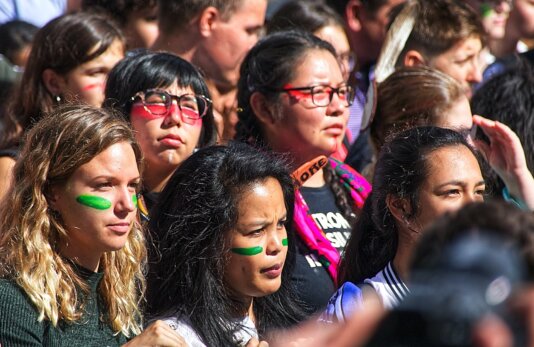- About
- Topics
- Picks
- Audio
- Story
- In-Depth
- Opinion
- News
- Donate
-
Signup for our newsletterOur Editors' Best Picks.Send
Read, Debate: Engage.

| topic: | Climate action |
|---|---|
| tags: | #climate change, #climate action, #gender equality, #Reproductive Rights |
| located: | Uganda |
| by: | Kathleen Mogelgaard |
Amid record-breaking heat and extreme weather events this summer, people all over the world, even those who have been relatively insulated from it thus far, are developing a more visceral sense of what it means to be vulnerable to climate change.
Whether it’s health effects of extreme heat and wildfire smoke, prolonged droughts impacting harvests, or floods leaving death and destruction in their wake, few of us feel untouched by climate threats. But it’s important to recognise that some places and populations are much more vulnerable than others.
Climate vulnerability isn’t just a function of weather and natural disasters. It’s also connected to what humans do or don’t do to plan, prepare, and adapt, and how communities and institutions are supported to influence outcomes for the better.
One powerful lever we have for influencing outcomes, but may not fully recognise, is addressing the gendered dimensions of climate impacts and adaptation needs, such as gender equity, sexual and reproductive health and rights and reproductive autonomy.
Global population surpassed 8 billion in 2022, and while aging demographics and population decline in some parts of the world are drawing attention, rapid population growth persists in many other places, with important yet often overlooked implications for vulnerability to climate change impacts.
New analysis from the Population Institute shows that in the 80 most climate-vulnerable countries (as ranked by ND-GAIN), the average annual population growth rate is 1.8 per cent, meaning that their populations would double in less than 40 years unless the trajectory shifts.
Rapid population growth increases the urgency and compounds the challenge of scaling up climate change adaptation measures. It can confound a community’s efforts to build resilience and adaptive capacity, especially in places where governments are already struggling to meet basic needs in climate-sensitive sectors like clean water supply, agricultural extension services, and health infrastructure.
Uganda, for example, is one of the world’s most climate-vulnerable countries. Prolonged drought in some areas of the country is linked to deep food insecurity and widespread hunger-related deaths.
In other areas, recent floods and landslides exacerbated by land degradation from unsustainable land use and unplanned urban growth have wreaked devastation.
Uganda’s current population growth rate is 2.8 per cent, which if left unabated would double the population in 25 years, putting more pressure on food security and land use and making it harder to adapt to the changing climate.
But the key word above is "if." In Uganda, as in many other places around the world, rapid population growth is linked to high rates of child marriage, persistent gender inequality, and a lack of meaningful access to reproductive health care and family planning services. There is progress on these fronts, but it’s slower than development goals aim for, and suffers from underinvestment. This serves to perpetuate gendered climate impacts.
Around the world, gender roles make women and girls more vulnerable to climate change. They are taken out of school to search for increasingly scarce water or fuel. They are more likely to remain in disaster-struck areas to care for the very young and very old. Women make up nearly half of the world’s smallholder farmers and produce 70 per cent of Africa’s food, yet they don’t have the same access as men to resources like agricultural extension services.
We urgently need climate action that is gender-responsive – interventions that recognise the gendered dimensions of climate impacts and adaptation and seek to advance gender equality. That means making sure women have a seat at the table when it comes to climate-related planning and decision-making.
It means assuring gender-equitable access to financial resources for climate adaptation. It also requires full access to voluntary family planning and reproductive health services, which today are out of reach for far too many people around the world.
Nearly half of all pregnancies are unintended. Reproductive autonomy - the ability to plan and space births and achieve one's desired family size - is a basic human right, and respecting it can reduce unintended pregnancies.
It can also help individuals and families better navigate and survive shocks and stressors in their lives, including the impacts of climate change. Over the long-term, it can slow population growth.
Climate change adaptation plans rarely take account of population trends, let alone address the gender equity and reproductive health factors underlying them.
But there is a growing movement of advocates, planners and programme managers advancing multisectoral approaches that connect climate planning to population assessments and interventions that slow population growth, such as investing in rights and opportunities for women and girls, addressing people’s reproductive health needs and advancing reproductive autonomy.
For example, the Uganda-based NGO Regenerate Africa works with civil society and government to build gender equity and reproductive health into national climate policies, including the Ugandan government’s Nationally Determined Contribution to meeting Paris agreement goals.
These sorts of climate interventions need and deserve deeper support from global institutions. Scaling them up is on the critical path to a more just and resilient future.
Kathleen Mogelgaard is President and CEO of the Population Institute in Washington, DC.
Image by Pascal Bernardon.